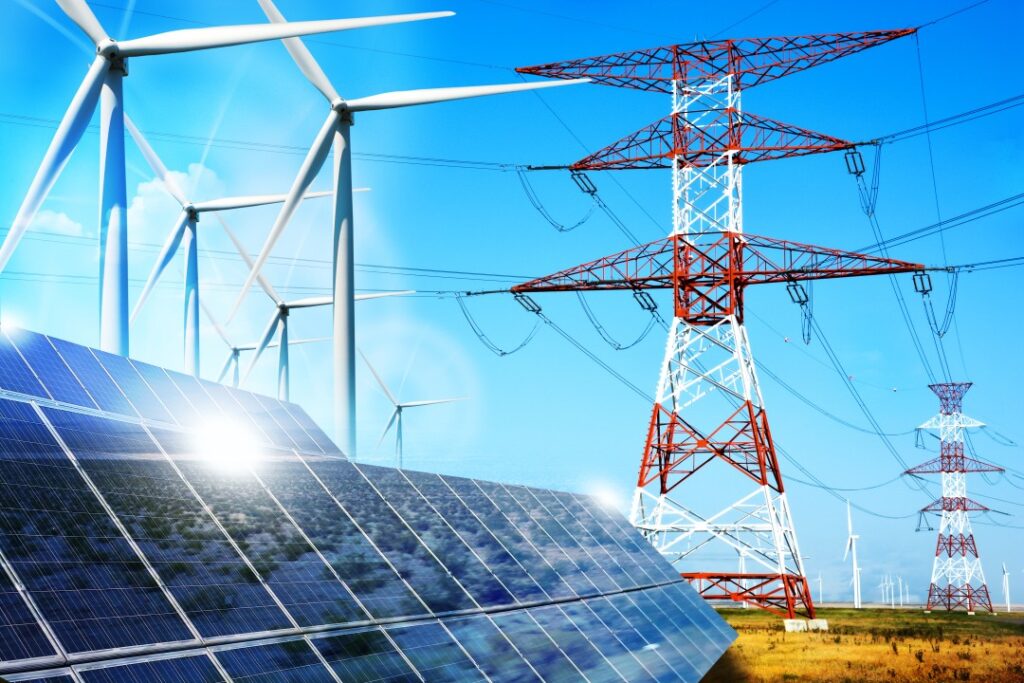The energy landscape is profoundly transforming as electricity providers adapt to the rapidly changing technological, environmental, and economic conditions. The push towards sustainable energy sources, the integration of advanced technologies, and evolving regulatory frameworks are shaping the future of electricity provision. This article explores the key advancements in the electricity sector for 2024 and beyond, illustrating how suppliers are adjusting to meet the demands of a more eco-friendly, smart, and resilient energy environment.
The Rise of Renewable Energy
Solar and Wind Power Expansion
Solar and wind power, among other renewable energy sources, lead the shift towards sustainable energy. Decreasing costs and favorable government policies drive the fast adoption of renewable energy technologies.
- Cost Reduction: Advances in technology and economies of scale have significantly reduced the cost of solar panels and wind turbines, making them more competitive with traditional fossil fuels.
- Increased Capacity: Global solar and wind energy capacity is expected to grow, with large-scale projects and distributed generation contributing to the energy mix.
- Energy Storage: Innovations in energy storage solutions, such as batteries, are enhancing the reliability and integration of renewable energy by addressing intermittency issues.
Decentralized Energy Systems
As in the Odessa Electric Company, the shift towards decentralized energy systems changes how electricity is generated, distributed, and consumed. Distributed generation, microgrids, and community solar projects are becoming more prevalent.
- Prosumers: Consumers who produce their energy, known as prosumers, contribute to the grid through rooftop solar panels and small wind turbines.
- Microgrids: Microgrids, which can operate independently or in conjunction with the primary grid, provide localized energy solutions and enhance grid resilience.
- Community Projects: Community solar projects allow multiple participants to share the benefits of a single solar installation, promoting access to renewable energy.
Smart Grids and Digitalization

Advanced Metering Infrastructure (AMI)
Advanced Metering Infrastructure (AMI) revolutionizes how electricity providers manage and monitor energy consumption. Smart meters, a vital component of AMI, offer numerous benefits.
- Real-Time Data: Smart meters allow consumers to access immediate information on their energy usage, allowing them to make educated choices about their consumption while also assisting providers in improving grid operations.
- Dynamic Pricing: AMI supports dynamic pricing models, such as time-of-use tariffs, which incentivize consumers to use electricity during off-peak hours, balancing demand and supply.
- Outage Management: Enhanced visibility into the grid allows for quicker detection and resolution of outages, improving reliability and customer satisfaction.
Internet of Things (IoT) Integration
The Internet of Things (IoT) is pivotal in modernizing the energy sector by connecting devices, systems, and infrastructure.
- Smart Appliances: IoT-enabled smart appliances can communicate with the grid, optimizing energy usage based on real-time conditions and reducing overall consumption.
- Grid Optimization: IoT devices provide valuable data on grid performance, facilitating predictive maintenance and efficient energy distribution.
- Demand Response: IoT technology enables demand response programs, where consumers adjust their energy usage during peak periods in response to signals from the utility, enhancing grid stability.
Blockchain for Energy Transactions
Blockchain technology is emerging as a powerful tool for enhancing transparency, security, and efficiency in energy transactions.
- Peer-to-Peer (P2P) Energy Trading: Blockchain enables secure and transparent peer-to-peer energy trading, allowing consumers to buy and sell excess energy directly.
- Traceability: Blockchain ensures the traceability of renewable energy certificates, providing verifiable proof of energy origin and supporting green energy initiatives.
- Smart Contracts: Smart contracts automate and enforce energy agreements, reducing administrative costs and enhancing transaction efficiency.
Decarbonization and Policy Support
Carbon Reduction Goals
Governments and organizations worldwide are setting ambitious carbon reduction goals to combat climate change and promote sustainability.
- Net-Zero Targets: Many countries and corporations have committed to achieving net-zero carbon emissions by mid-century, driving the adoption of renewable energy and energy efficiency measures.
- Regulatory Incentives: Policy incentives, such as tax credits, subsidies, and renewable portfolio standards, encourage investment in clean energy technologies.
Electrification of Transportation
The electrification of transportation is a critical component of decarbonization efforts, with significant implications for electricity providers.
- Electric Vehicles (EVs): The increasing adoption of electric vehicles drives demand for electricity and necessitates the development of charging infrastructure.
- Vehicle-to-Grid (V2G): V2G technology allows EVs to discharge electricity back to the grid, providing additional storage capacity and supporting grid stability.
- Charging Infrastructure: Expanding charging networks, including fast-charging stations, is essential to support the growing number of EVs and facilitate their integration into the energy system.
Energy Efficiency Programs
Energy efficiency programs reduce energy consumption and lower carbon emissions by promoting the adoption of energy-saving technologies and practices.
- Building Retrofits: Retrofitting buildings with energy-efficient technologies, such as LED lighting, smart thermostats, and high-efficiency HVAC systems, reduces energy demand.
- Appliance Standards: Stringent efficiency standards for appliances and equipment drive innovation and reduce energy consumption.
- Consumer Education: Programs that educate consumers about energy efficiency and provide incentives for adopting energy-saving measures are essential to achieving energy reduction goals.
Enhancing Grid Resilience
Climate Adaptation
As climate change increases the frequency and severity of extreme weather events, enhancing grid resilience is becoming a top priority for electricity providers.
- Grid Hardening: Investments in grid hardening, such as undergrounding power lines and reinforcing infrastructure, reduce the grid’s vulnerability to weather-related disruptions.
- Weather Forecasting: Advanced weather forecasting and predictive analytics enable providers to anticipate and prepare for extreme weather events, minimizing their impact on the grid.
- Distributed Energy Resources (DERs): DERs, such as solar panels and battery storage, provide localized energy solutions that enhance grid resilience during outages.
Cybersecurity
The increasing digitalization of the energy sector requires robust cybersecurity measures to protect critical infrastructure from cyber threats.
- Threat Detection: Advanced cybersecurity tools, such as AI and machine learning, enhance the detection and mitigation of cyber threats in real time.
- Resilience Planning: Developing comprehensive resilience plans that include incident response and recovery strategies is essential for minimizing the impact of cyberattacks.
- Regulatory Compliance: Adhering to cybersecurity regulations and standards, such as the NIST Cybersecurity Framework, ensures electricity providers implement best practices for protecting their systems and data.
The Role of Artificial Intelligence and Big Data
Predictive Analytics
Predictive analytics powered by AI and big data transform how electricity providers manage operations and plan for the future.
- Load Forecasting: AI algorithms analyze historical and real-time data to forecast electricity demand accurately, enabling better resource planning and grid management.
- Maintenance Scheduling: Predictive maintenance, driven by data analytics, identifies potential equipment failures before they occur, reducing downtime and maintenance costs.
- Energy Management: AI-driven energy management systems optimize energy usage across industrial, commercial, and residential sectors, improving efficiency and reducing costs.
Customer Engagement
AI and big data enhance customer engagement by providing personalized experiences and improving service delivery.
- Customer Insights: Data analytics provide deep insights into customer behavior and preferences, enabling providers to offer tailored energy solutions and services.
- Chatbots and Virtual Assistants: AI-powered chatbots and virtual assistants enhance customer service by handling inquiries, processing requests, and providing energy-saving tips.
- Demand Response Programs: Data-driven demand response programs engage customers in managing their energy usage, rewarding them for reducing consumption during peak periods.
Future Innovations and Emerging Technologies
Hydrogen Energy
Hydrogen is emerging as a versatile and sustainable energy carrier with the potential to complement renewable energy sources.
- Green Hydrogen: Produced using renewable energy, green hydrogen can be used for energy storage, transportation, and industrial applications, reducing carbon emissions.
- Fuel Cells: Hydrogen fuel cells generate electricity through a chemical reaction, offering a clean and efficient power source for various applications.
Fusion Energy
Fusion energy, which replicates the processes occurring in the sun, has the potential to provide virtually limitless and clean energy.
- Technological Advances: Significant progress in fusion technology, such as breakthroughs in magnetic confinement and plasma stability, is bringing fusion energy closer to reality.
- Pilot Projects: Pilot fusion projects like ITER are paving the way for commercial fusion reactors that could revolutionize the energy landscape.
Advanced Nuclear Energy
Advanced nuclear technologies, such as small modular reactors (SMRs) and thorium reactors, offer safe and efficient alternatives to traditional nuclear power.
- Safety Improvements: Innovations in reactor design and safety systems are enhancing the safety and reliability of nuclear energy.
- Scalability: SMRs provide scalable and flexible energy solutions, making nuclear power more accessible and economically viable.
Conclusion
A confluence of technological advancements, policy initiatives, and evolving consumer expectations is shaping the future of energy. Electricity providers are at the forefront of this transformation, embracing renewable energy, smart grid technologies, and innovative solutions to enhance sustainability, reliability, and customer engagement. As we look ahead to 2024 and beyond, the continued evolution of the energy sector promises to deliver a cleaner, brighter, and more resilient energy future for all.

